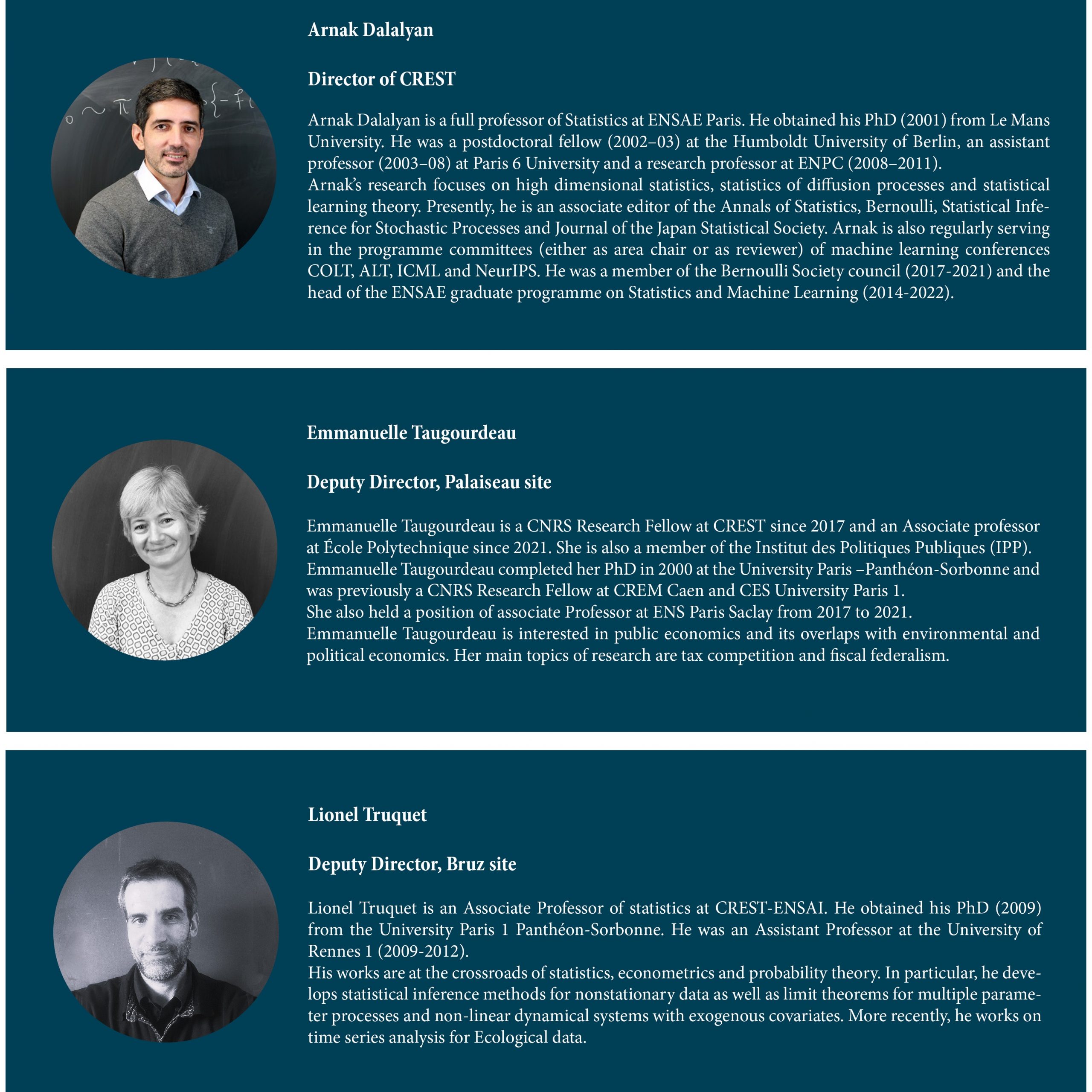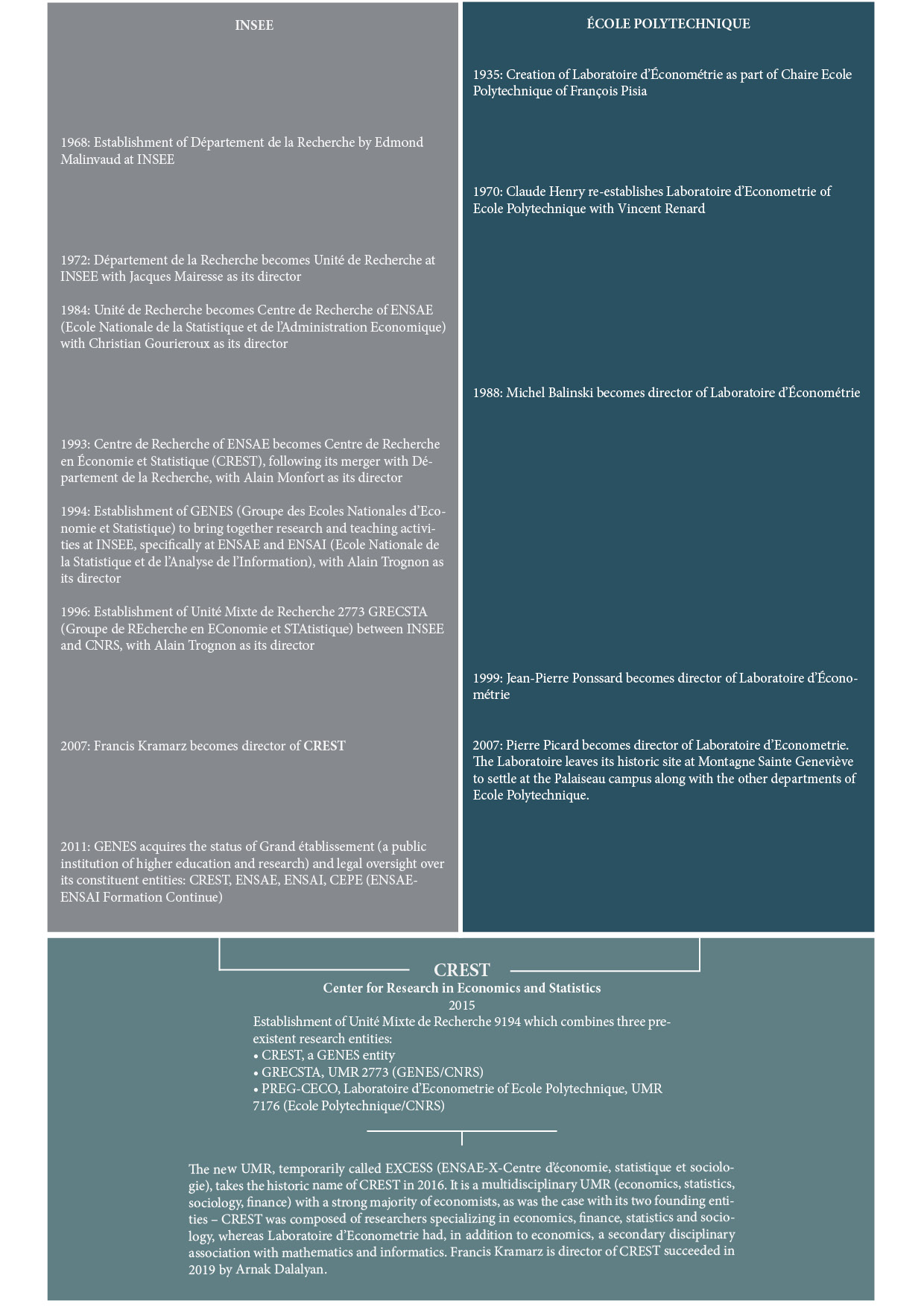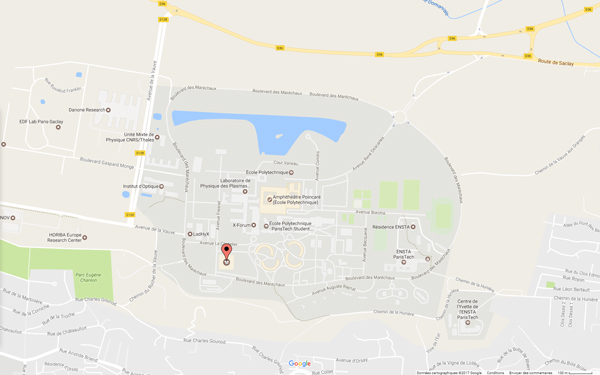The Center for Research in Economics and Statistics (CREST) is a French scientific research institution specialising in quantitative methods applied to the social sciences.
CREST is a joint interdisciplinary unit made up of researchers and teachers from the CNRS, GENES ,the Economics Department of École polytechnique and the SES department of Télécom Paris. Its activities are physically located in the ENSAE Paris building on the Palaiseau campus of Institut Polytechnique de Paris and on the Ker-Lann campus of ENSAI Rennes.
CREST’s common culture is characterised by a strong commitment to quantitative methods, mathematical modelling and the interplay between models and empirical facts in order to analyse economic and social problems. The laboratory’s main areas of research are economics, finance, statistics, actuarial sciences and sociology.
One of the main challenges of the laboratory’s scientific production project is the national and international promotion of its activities.
The CREST laboratory enjoys national and international recognition thanks to the excellence of its research. Our researchers are committed to creating and disseminating cutting-edge knowledge, thus making a significant contribution to the global scientific community. This excellence is evident in the quality of academic journals publishing the work of our researchers, such as the American Economic Review, the Journal of Political Economy, the Annals of Statistics, the Journal of the Royal Statistical Society, and the Annual Review of Sociology. These achievements illustrate the significant impact of our laboratory in economics, statistics, finance and insurance, and sociology.
CREST also owes its international visibility to its diverse community of 250 professors, researchers, and doctoral students. Fundamentally interdisciplinary, CREST conducts innovative research in various fields of economics (microeconomics, labor economics, environmental economics, etc.), statistics (nonparametric statistics, high-dimensional statistics, machine learning, etc.), finance and insurance (financial econometrics, sustainable and environmental finance, geometry for optimization and learning, etc.), and sociology (politics, artificial intelligence, inequalities and discrimination, etc.).
CREST offers its researchers optimal research conditions, both in terms of equipment and funding. This enables it to recruit post-docs, assistants and associate professors on the international academic job market every year.
Research at CREST benefits from :
- Competitive external grants from the European Research Council (ERC) and the French National Research Agency (ANR);
- An ANR-funded Laboratory of Excellence in Economics and Decision Sciences (LabEx ECODEC, in partnership with HEC Paris);
- Hi! PARIS, the Centre for Data Analysis and Artificial Intelligence for Science, Business and Society, set up by Institut Polytechnique de Paris (IP Paris), HEC Paris and Inria;
- E4C, the inderdisciplinary Energy4Climate Center set up by Institut Polytehnique de Paris and the École des Ponts ParisTech;
- The University Research School (EUR), financed by public funds, to strengthen Master’s and PhD level training:
- EUR “Data Science for Economics, Finance and Management” in partnership with HEC Paris.
- EUR “CyberSchool” and “Digisport” in partnership with the University of Rennes.
- Institut des Politiques Publiques (IPP), in partnership with Paris School of Economics;
- Institut Polytechnique Experimental Lab (IPEL);
- Research chairs and doctoral fellowships supported by public-private partnerships.

Beyond its primary research objectives, CREST places significant emphasis on cultivating and disseminating its scientific culture and expertise through graduate education.
Master programmes
At the Master’s level, the programmes in which CREST members are most deeply engaged include:
CREST members are heavily involved in the teaching of engineering programmes at the Ecole polytechnique, ENSAE and ENSAI. Students graduating from these programmes obtain an engineering diploma equivalent to a master’s degree.
Watch this video to discover more about our Graduate Programme in Economics, a collaborative effort between Ecole Polytechnique and ENSAE Paris at the Institut Polytechnique de Paris.
Doctoral programmes
At doctoral level, CREST offers very attractive research conditions for students wishing to carry out their doctoral thesis at the Institut Polytechnique de Paris or ENSAI.
Our doctoral students have an excellent placement rate in the private, public and academic sectors in France and abroad, including universities such as Berkeley, Chicago, Cornell, Harvard and Princeton.
In addition, the 5-year integrated PhD track programmes at the Institut Polytechnique de Paris offer students the opportunity to develop advanced research skills along a doctoral pathway encompassing master’s and PhD training. CREST participates in PhD Track programmes in economics (in cooperation with HEC Paris), Data & Artificial Intelligence and Mathematics.
CREST doctoral students can make academic visits to prestigious universities. The purpose of these visits is to enable them to meet the world’s leading researchers in their field and to present their own work. Our doctoral students have spent several months at Harvard University and the University of California, Berkeley, two of the world’s most renowned institutions for research in economics and the social sciences.
After successfully defending their thesis, PhD students embark on a global job search through the international job market. CREST offers comprehensive support to assist them in crafting competitive applications and achieving success in their endeavors. As a result of these dedicated efforts, our candidates have recently secured positions at esteemed universities across Europe and worldwide, including institutions such as Princeton, Cornell, UCLA, Bocconi, LMU, and PSE.
Watch this video to hear from two CREST doctoral students who graduated in Economics in 2023, as they share their journey through the doctoral program, culminating with their experiences on the International Job Market.

DOCUMENTS
CREST resulted from the fusion in 2015 of research institutions with a long history of collaboration but which evolved separately at Ecole Polytechnique and at Institut National de la Statistique et des Etudes Economiques (INSEE). Here is a brief institutional history:
1935: Creation of Laboratoire d’Économétrie as part of Chaire Ecole Polytechnique of François pisia
1968: Establishment of Département de la Recherche by Edmond Malinvaud at INSEE
1970: Claude Henry re-establishes Laboratoire d’Econometrie of Ecole Polytechnique with Vincent Renard
1972: Département de la Recherche becomes Unité de Recherche at INSEE with Jacques Mairesse as its director
1984: Unité de Recherche becomes Centre de Recherche of ENSAE (Ecole Nationale de la Statistique et de l’Administration Economique) with Christian Gourieroux as its director
1988: Michel Balinski becomes director of Laboratoire d’Économétrie
1993: Centre de Recherche of ENSAE becomes Centre de Recherche en Économie et Statistique (CREST), following its merger with Département de la Recherche, with Alain Monfort as its director
1994: Establishment of GENES (Groupe des Ecoles Nationales d’Economie et Statistique) to bring together research and teaching activities at INSEE, specifically at ENSAE and ENSAI (Ecole Nationale de la Statistique et de l’Analyse de l’Information), with Alain Trognon as its director
1996: Establishment of Unité Mixte de Recherche 2773 GRECSTA (Groupe de REcherche en EConomie et STAtistique) between INSEE and CNRS, with Alain Trognon as its director
1999: Jean-Pierre Ponssard becomes director of Laboratoire d’Économétrie
2007: Pierre Picard becomes director of Laboratoire d’Econometrie. The Laboratoire leaves its historic site at Montagne Sainte Geneviève to settle at the Palaiseau campus along with the other departments of Ecole Polytechnique.
2007: Francis Kramarz becomes director of CREST
2011: GENES acquires the status of Grand établissement (a public institution of higher education and research) and legal oversight over its constituent entities: CREST, ENSAE, ENSAI, CEPE (ENSAE-ENSAI Formation Continue)
2015: Establishment of Unité Mixte de Recherche 9194 which combines three pre-existent research entities:
– CREST, a GENES entity
– GRECSTA, UMR 2773 (GENES/CNRS)
– PREG-CECO, Laboratoire d’Econometrie of Ecole Polytechnique, UMR 7176 (Ecole Polytechnique/CNRS)
The new UMR, temporarily called EXCESS (ENSAE-X-Centre d’économie, statistique et sociologie), takes the historic name of CREST in 2016. It is a multidisciplinary UMR (economics, statistics, sociology) with a strong majority of economists, as was the case with its two founding entities – the historic CREST was composed of economists, statisticians and sociologists, whereas Laboratoire d’Econometrie had, in addition to economics, a secondary disciplinary association with mathematics and informatics. Francis Kramarz is director of CREST succeeded in 2019 by Arnak Dalalyan.
CREST activities are located physically in the ENSAE Paris building on the Palaiseau campus of Institut Polytechnique de Paris and secondarily on the Bruz campus of ENSAI Rennes.
For directions to Bruz campus of ENSAI Rennes see here.
For directions to Palaiseau campus of Institut Polytechnique de Paris:
Just 20 km south of Paris on a site spanning almost 160 hectares, the CREST can be reached from several access points.
The reception service
The reception service of CREST is located in the hall of the ENSAE Paris building, accessible from Avenue Fresnel.
The reception service welcome visitors on weekdays from 8 am to 6 pm and can be reached at +33 (0)1 70 26 67 00.
They are responsible for welcoming, informing and guiding visitors. They can also accompany them, if necessary, to their meeting places. They help with taxi bookings and lost items management as well.
The site
CREST – UMR 9194
5, Av Henry Le Chatelier
91120 Palaiseau,
FRANCE
Visit us through Google Maps:
Access using public transport:
2 routes are available: one from the Massy-Palaiseau station and the other one from the Lozère station.
Connecting buses link the stations to the campus.
- – RER B Massy-Palaiseau station
Map of Massy Palaiseau station and bus stops
At the station, use the TransEssonne 91.06 (B,C) or 91.10 bus
Drop off at: the “Polytechnique Lozère” stop.
– RER B Lozère station
15-minute walking route (and approx. 300 steps to climb).
Map of the Lozère station.
Map of the itinerary from the lozère station.
Find the train schedule and prepare your trip.
Access by road
From the Porte d’Orléans or Porte d’Italie: use the A6 highway.
From the Pont de Sèvres : use the N118 road.
Consult the traffic status in real time.
Local airports
– Orly airport (use the RER B and Orly Val)
– Roissy-Charles de Gaulle airport (use the RER B)
– Villacoublay airport
– Toussus-le-Noble business airport
Download the map of airports, stations and RER stations.
Palaiseau Campus IP Paris
Located on the Plateau de Saclay, the Institut Polytechnique de Paris campus brings together its five founding Schools: École Polytechnique, ENSTA Paris, ENSAE Paris, Télécom Paris, and Télécom SudParis. It offers students, faculty members and staff top-notch facilities to pursue their activities in a lively and stimulating environment. Set in the heart of one of the world’s top eight innovation hubs, the campus benefits from the dynamism created by the private and public players based within the cluster. Ideally located just outside Paris, the campus is easily accessible by public transportation, allowing students and faculty members to take advantage of the economic dynamism and rich cultural life of the French capital.Discover the campus:
Bruz-Rennes Campus ENSAI
ENSAI is located on the beautiful Bruz Campus, just outside Rennes, a festive, creative, vibrant, young city with medieval and modern architecture.The campus is located on a wooded, 165-hectare plot of land within the suburban town of Bruz. The calm, verdant campus is home to institutions of higher education, professional training centers, and businesses. Bruz’s mixed use makes it a unique place in Rennes and an enjoyable place to study.



